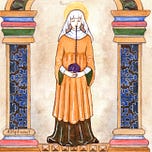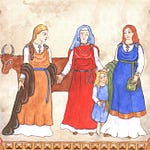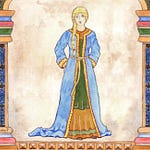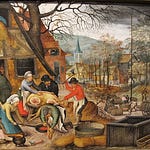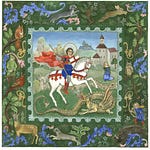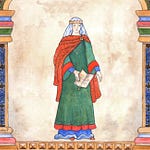Ælfgif-who? provides short biographies of early medieval English women every two weeks. Click on the podcast player if you’d like to hear this newsletter read aloud in my appealing Yorkshire accent. Content note: Reference to infanticide.

Saint Leoba: Leading figure in the Christianisation of Germany
Leoba was born in Wessex in the early eighth century. She became the leading female figure in Saint Boniface’s mission to convert non-Christians in Germany, and became the abbess of Tauberbischofsheim. Her saints life was recorded half a century after her death by Rudolf, a monk of Fulda, after he spoke to many of her contemporaries, including four nuns who were under her authority as abbess.
According to Rudolf’s life, Leoba was born to elderly parents, Dynne and Æbba, who had almost given up hope of having a child. They promised that if God gave them a daughter, they would give her over to a monastic life. When they miraculously had Leoba in their old age, they honoured their promise and gave her to a nunnery at Wimborne under the supervision of Abbess Tetta. It was at Wimborne that the young Leoba had a prophetic dream. According to Rudolf:1
She had a dream in which one night she saw a purple thread issuing from her mouth. It seemed to her that when she took hold of it with her hand and tried to draw it out there was no end to it; and as if it were coming from her very bowels, it extended little by little until it was of enormous length. When her hand was full of thread and it still issued from her mouth she rolled it round and round and made a ball of it.
The dream was interpreted by one of the older nuns, who had the gift of foresight, who saw the purple string as a sign that Leoba would speak wise counsel from the heart, and her rolling it in her hand suggests that she will set her deeds in motion. In telling this story, Rudolf indicates that Leoba was destined for greatness.
While Leoba was at Wimborne, the English bishop Boniface, a relative of her mother and friend of her father, began recruiting English religious figures to join him on his mission in Germany, converting the non-Christians there. In 731 he was made an archbishop with considerable authority east of the Rhine. At some point after 732 Boniface and Leoba began corresponding. In on of their surviving letters, Leoba writes about her father’s death eight years earlier and her mother’s poor health. She asks if she may consider him as her brother, and goes on to tell him that she has been studying the art of writing poetry under the guidance of a woman called Eadburga. She then signs off with a poem that she has written for Boniface, which reads:2
Farewell, and may you live long and happily, making intercession for me.
The omnipotent Ruler who alone created everything,
He who shines in splendour forever in His Father's kingdom,
The perpetual fire by which the glory of Christ reigns,
May preserve you forever in perennial right.
This poem can be considered alongside the work of Hugeburc, another eighth-century English nun at a German monastery, who wrote the earliest full-length literary work that can be ascribed to an English woman, in the form of a saints life. This short verse by Leoba, written a few decades before Hugeburc’s longer literary endeavour, and inspired by the teaching of another abbess, Eadburga, indicates that women’s literary culture in the evangelising monastic communities of Germany may have been a much more flourishing phenomenon than this important but limited source material can reveal. While Leoba’s poetry has been dismissed by scholars as derivative or basic, her Latin is fluent and fits the tone of her letter, which is designed to cement her relationship with Boniface.
Their relationship was seemingly strengthened by their correspondence. Boniface invited Leoba to join him in Germany, and though it is not known when she made the journey, she was almost certainly there by 748. Not only did Boniface found a monastery for Leoba to preside over as abbess at Tauberbischofsheim, but she was also granted the power to oversee all nuns involved in Boniface’s mission. She was effectively Boniface’s second-in-command, along with Sturm, the abbot of Fulda, who had similar authority over all monks. Boniface gifted Leoba his cowl, before he set off in 754 to undertake missionary work in Frisia, where he and his companions would ultimately be murdered by thieves. Their bodies were taken to Fulda, where Leoba would regularly visit in the coming years, the only woman allowed into the monastery due to Boniface’s wishes that she be buried by his side in his tomb when she died.
Leoba continued as abbess of Tauberbischofsheim for almost another three decades, in which she oversaw its transformation into an important centre of learning. At least four abbesses were trained under Leoba’s authority there. Her hagiographer Rudolf paints her as the protector of her monastery’s good reputation: suspicion fell on the nuns when a drowned newborn was found in a nearby millpond. Leoba responded by organising a number of prayers and processions that caused a vision of flames to appear around the real culprit: a disabled beggar who had previously sought food and clothing at Tauberbischofsheim. The nuns were relieved to be absolved of the crime, but there is no mention of the fate of the beggar.
Leoba was active in the Frankish court under Pippin and Charlemagne, and she was close to Charlemagne’s wife Hildegard. Nevertheless, her hagiographer Rudolf makes it clear that her heart was in her monastic career and not the glamour of the royal court, which she ‘detested like poison’. After twenty eight years as abbess at Tauberbischofsheim, Charlemagne granted her a royal estate near Mainz, and she retired there as an old woman with a group of nuns. She died there on the 28th September 782.
Though Boniface had requested for her to be buried beside him, the monks of Fulda did not wish to disturb his tomb, and she was buried in the crypt there. Her bones were translated to a new location in the church twice, the latter time in the 830s, possibly coinciding with the writing of her Saints Life by Rudolf of Fulda, in 836. The Life is dedicated to another abbess called Hadamout, possibly Abbess Hathumod of Gandersheim, likely intended to serve as a good example for her.
Leoba was certainly one of the most prominent figures in the English Bonifacian mission to Germany. She was so intimately connected with Boniface that she considered him a brother and he wished for her to share his tomb for eternity. Though her kinship with Boniface contributed to her meteoric rise, her correspondence to him suggests that she was an educated woman interested in cultivating her relationship with him and his mission. While acting as second-in-command to Archbishop Boniface, and presiding over the activity of all the nuns involved in the mission, Leoba became a leading church figure. Her status was so high that her realm of influence even extended to the Carolingian court. While her saint’s life highlights her personal piety and her monastic activities, Leoba also operated as a politician and administrator, planning and controlling the missionary activity amongst the institutions she oversaw, and advocating for her cause in the highest circles imaginable.
Suggestions for further reading:
Medieval Sourcebook: Rudolf of Fulda, Life of Leoba
Diane Watt, Anglo-Saxon Women Writers and their Manuscripts in the Bayerische Staatsbibliothek
Diane Watt, Women, Writing and Religion in England and Beyond, 650-1100, 2019
Peter Dronke, Women Writers of the Middle Ages (affiliate link), 1984
A letter from Lioba/Leobgytha/Leoba, abbess of Tauberbischofsheim (c.732)
Translated from Latin: https://sourcebooks.fordham.edu/basis/leoba.asp
Ephraim Emerton, The Letters of Saint Boniface (New York: Columbia University Press, 1940, repr.2000), pp. 37-8, reprinted online by Epistolae: Medieval Women’s Latin Letters.

